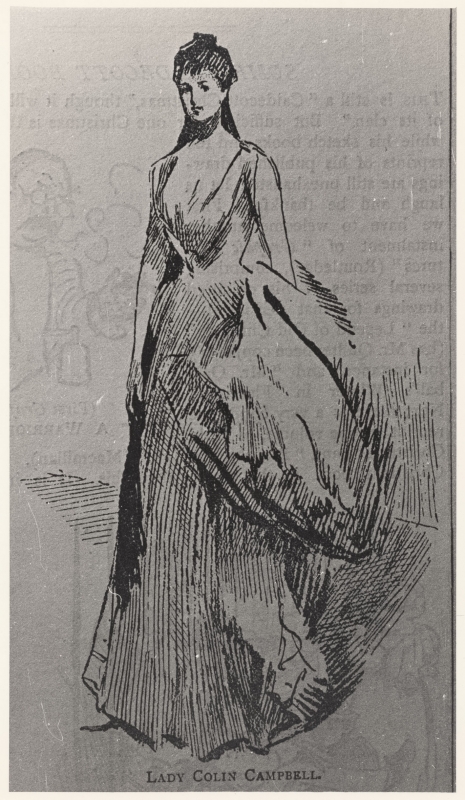Provenance
Unknown. After the exhibition in 1886, no further reference is known.
Exhibitions
- 1886: Winter Exhibition, Society of British Artists, London, 1886 (cat. no. 259) as 'Harmony in White and Ivory: Portrait of Lady Colin Campbell'.
Lady Colin Campbell herself exhibited a sketch in the Society of British Artists winter exhibition of 1886-1887 (cat. no. 101). This, as well as Whistler's portrait of her, enjoyed a certain controversial success.

J. B. Partridge, At the Whistleries, Suffolk Street, drawing for Judy, Fogg Art Museum, Cambridge, MA
A page of sketches and caricatures of Whistler's exhibits at the SBA was drawn by J. Bernard Partridge (1861-1945) and published under the title 'At the Whistleries Suffolk Street', in Judy; or the London Serio-Comic Journal, 8 December 1886, p. 267.
The Pall Mall Gazette on 30 November 1886 commented favourably on Whistler and his influence on the SBA:
'As a whole, in spite of plentiful rejections of imitations of the presidents manner, the exhibition is distinctly one of "impressionists" and the kindred schools. The first to be considered, of course, is Mr. Whistler's full-length unfinished portrait of Lady Colin Campbell, " A Harmony in White and Ivory" (259). It is the portrait of a beautiful, stately, refined, and graceful woman. She is represented in evening costume, holding up the train of her dress (as will be seen from the sketch the artist has kindly caused to be made for us), a highly skilful piece of work.' 1
Whistler's portrait was described in the 1886 catalogue as 'unfinished'. Wyke Bayliss (1835-1906), who later succeeded Whistler as president of the RBA, suggested that the portrait should be removed from the exhibition, although whether on the grounds of the unfinished state of the picture as suggested by the Pennells, or because of the scandal surrounding the sitter is not clear. 2 George Bernard Shaw (1856-1950), newly appointed art critic of The World, certainly thought that since the portrait was 'unfinished', it had 'no business in the gallery.' 3 The Era on 11 December 1886 commented cryptically on the timing of the exhibit and its unfinished state:
'The most important of his exhibits (for other than artistic reasons) is ... " Harmony in White and Ivory," more interesting to the public just now from its sub-title, Portrait of Lady Colin Campbell. The picture is unfinished, especially about the head; and it is not, perhaps, our business to inquire what motive induced the artist to prematurely thrust this particular portrait upon the public. The lady is standing erect in a white evening-dress, with a sortie de bal thrown carelessly over the left arm, and the artist has made her "more than common tall;" indeed, for exaggeration of length, she rivals the figures in a French fashion-plate.'
In 1892 David Croal Thomson (1855-1930) suggested paintings that could be included in Whistler's retrospective at Goupil's, adding 'if you could consent to show the portrait of Lady Colin Campbell in white we should be specially pleased.' 4 However, it may have already been destroyed by the artist and was never exhibited again.
Notes:
1: This review and image were also published a few days later in 'Under Mr. Whistler's Regime', Pall Mall Budget, London, 2 December 1886.
2: Pennell 1908 [more] , vol. 2, p. 63; SBA minutes, 1 November 1886, Tate Archives.
3: 'G. B. S.', [Shaw, George Bernard], [Review of Society of British Artists], The World, London, 8 December 1886.
Last updated: 23rd May 2021 by Margaret






